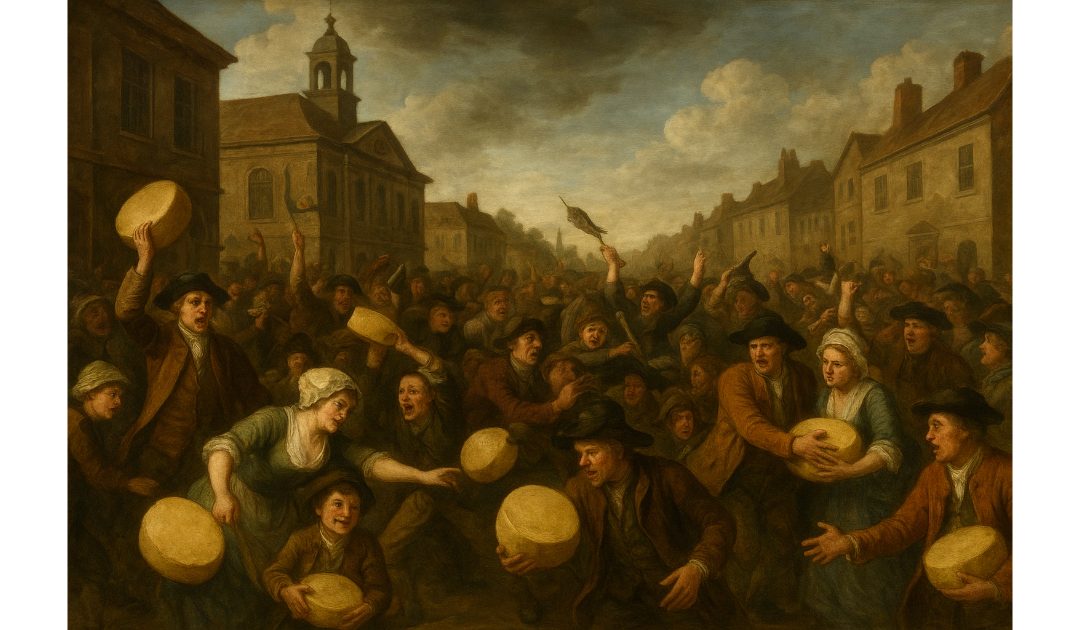My choice of historical event of the day is quite unusual, and I confess that I had not heard of the Nottingham Cheese Riot until today. I usually look for something I can link to that I have previously posted, for SEO (search engine optimisation), but I can’t think of anything. So I’m just going to come clean and say that I’m the author of the Sir Anthony Standen Adventures, and that Standen was an Elizabethan spy and the elder brother of my 10th great-grandfather. So with that out of the way, let’s get back to cheese.
The Nottingham Cheese Riot, also known as the Nottingham Cheese War, was an extraordinary civil disturbance that took place in Nottingham, England, on the 2nd of October, 1766. This tumultuous event stemmed from the volatile combination of high food prices, scarcity of essential goods, and growing dissatisfaction among local residents, culminating in a dramatic confrontation at the city’s famous Goose Fair.
In the mid-18th century, Britain was grappling with economic difficulties, agricultural issues, and fluctuating food supplies. The summer of 1766 had been notably harsh; poor harvests led to widespread food shortages, driving prices sky-high. Nottingham, like many other towns, was heavily affected. The annual Goose Fair, a bustling event traditionally held in early October, was a key marketplace where traders from surrounding regions gathered to sell goods, including large quantities of cheese—an essential commodity for many families.
On that fateful day, tensions were already palpable. The price of cheese, a staple in many households, had surged dramatically due to the supply shortage. Local residents, frustrated and desperate, arrived at the fairgrounds to find that merchants were charging exorbitant prices. The discontent quickly escalated into anger as crowds accused traders of profiteering and exploiting the crisis.
The riot began when a group of incensed citizens attempted to prevent merchants from transporting cheese out of Nottingham, fearing that exporting it would further deplete local supplies and raise prices even more. They intercepted carts loaded with cheese, overturning them and seizing the contents. Some accounts describe rioters rolling enormous wheels of cheese through the streets, creating chaos and obstructing traffic.
The situation rapidly spiralled out of control. As more people joined the fray, the disturbance grew into a full-scale riot. Traders tried to defend their goods, leading to scuffles. The local authorities, overwhelmed by the scale of the unrest, called in the militia to restore order. The militia’s intervention, however, exacerbated the violence. Armed confrontations ensued, and several people were injured amid the melee.
The rioters’ actions were not merely about theft or vandalism; they reflected deep-seated grievances about economic inequality and injustice. The sight of common townsfolk clashing with both traders and soldiers underscored the desperation and frustration boiling beneath the surface of 18th-century British society. The rebellion was symbolic of the broader struggles faced by the working class during a time of economic hardship and governmental neglect.
In the aftermath, the authorities managed to quell the riot, but not without significant damage to property and numerous injuries. Several rioters were arrested and faced harsh punishments, serving as a stern warning against future insurrections. However, the underlying issues—food scarcity, price inflation, and economic disparity—remained unresolved, continuing to simmer within the community.
The Nottingham Cheese Riot holds historical significance beyond its immediate impact. It highlights the critical role that food security played in social stability during pre-industrial Britain. The riot also exemplified how quickly civil order could disintegrate when basic needs were threatened.
Moreover, the event shed light on the importance of market regulation. The authorities recognised the need for better oversight to prevent price gouging and ensure fair access to essential commodities. Over time, such incidents influenced reforms aimed at stabilising food supplies and controlling market practices to avoid similar outbreaks of unrest.
Culturally, the riot became part of Nottingham’s local heritage, often recounted in historical narratives and folklore. It serves as a vivid reminder of the city’s vibrant, sometimes tumultuous past and the resilience of its people in the face of adversity.
Today, the Nottingham Cheese Riot is occasionally referenced in discussions about food-related protests and civil disturbances. It stands as an early example of how economic pressures can ignite public outrage, leading to spontaneous yet impactful acts of resistance.

